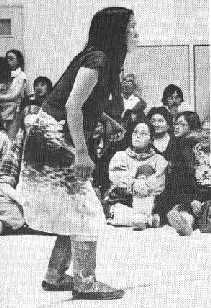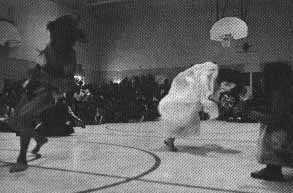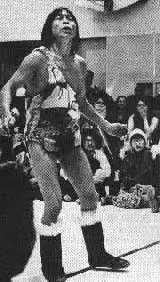NORTH SLOPE BOROUGH, P. O. BOX 69, BARROW ALASKA 99723
TELEPHONE (907) 852-2611
Issue No: Seven______________Part 2_____________Date:October, 1977
IGPAKUHAK (Copper Eskimo man, Victoria Land)
Hymn to the Spirit of the Ah
I stand here humbly with extended arms,
for the spirit of the air
has brought down game for me!
I stand here
surrounded by great joy,
for a reindeer with tall antlers carelessly exposed his flanks to me!
Ah, how I crouched in my hunter’s hide!
But scarcely had I glimpsed his flanks,
than my arrow pierced them. haunch to haunch.
And then, beloved reindeer, as you pissed there,
as you fell,
I was surrounded by great joy!
I stand here humbly with extended arms,
for the spirit of the air
has brought down game for me!
I stand here humbly with extended arms,
surrounded by great joy:
an old seal-bull
was blowing through his breathing-hole, and I, a little man,
stood upright over him.
The tension
made my body longer,
till I drove my harpoon down,
and tied him
to the harpoon-rope.
NSB COASTAL ZONE MANAGEMENT PROGRAM ENTERS PHASE ONE
The work of Inventory and Analysis was begun with the delivery to the Borough by the Arctic Environmental Information and Data Center (U of A) of four maps of the coastal zone with graphics and annotations depicting: 1. locations of important habitats and biological communities; 2. locations of geologic, topographic or water situations particularly suitable for industrial, commercial or community development; 3. locations of environmental hazard conditions or areas where use should be limited because of erosion, storm surges and floods, slides, etc.; and 4. locations of significant land or water resources or situations requiring particular protection or management consideration (i.e. gravel deposits, water recharge areas, beaches, etc.).
The NSB Coastal Zone Management Program, begun last year as part of its comprehensive planning effort, is directed mainly at developing an awareness of the coastal area’s importance to people within the North Slope Borough, and to those outside who may have an effect upon the Borough’s coastal resources. This is especially important in light of the stepped-up petroleum exploration activities within National Petroleum Reserve No. 4, continued exploration and development in and adjacent to the Prudhoe Bay fields, the gas pipeline and associated development soon to occur, and future offshore oil and gas activities. To cope with this development while protecting ecological, cultural, historic and esthetic values is an immediate need which will be compounded in the future. The program directors aim to develop plans and measures to protect and rationally use lands and waters of its coast, so that elements such as resource development and subsistence use may’ both continue to thrive while minimizing adverse interactions. Since Prudhoe Bay will be the area subjected to the most intensive development during the next several years, rapid development of a coastal zone management program for this area is seen as essential.
By Earl Finkler
The new subdivision regulations would give the Borough jurisdiction over the opening or development of any road within its borders, whether such a road was on private or public land. The Borough could impose any number of standards or conditions before accepting any new public roads such as the Haul Road. These standards could possibly include minimal impact on prime wilderness and subsistence areas and also some Borough review of maintenance, design and construction techniques.
The North Slope Borough has always possessed strong planning, zoning; and land use management powers since it was incorporated in 1972. In fact, when the formation of the Borough was challenged in court by the oil companies, both the Local Boundary Commission and the Court noted that comprehensive land use planning by the Borough would be highly important to both the subsistence way of life and to energy development. If the development of oil and gas fields was to be compatible with continued region-wide hunting and fishing, the entire area would have to be subject to local government planning and regulation, the Court and the Commission agreed. They added that this meant areas such as Petroleum Reserve Number 4 and other areas called “unused” by the oil companies could not be excluded from the Borough or from Borough control.
It is one thing to have such local powers, however, and quite another to get them into effective operation. The Borough has been developing a strong planning function for some time, but it has also had to fight in the courts for its basic existence and its financial independence. Effective planning and direction of the major Capital Improvements Program also requires a lot of staff time, including that of the Planning Department. Thus, up until now, the Borough’s zoning and subdivision ordinances have been quite simple and applied on a very limited basis.
Another major stumbling block in effective Borough control of its jurisdiction was the myth that few if any local zoning or land use controls could be applied to federally owned or even State-owned lands. Federal and State agencies often appeared to bask in the security of such an assumption. For over two years now, there has been extensive federal and state study of options and plans for the Haul Road. Reams of paper have been produced and major public meetings have been held, but the Borough and its interests and powers have been all but ignored. As late as the end of July, 1977, only about five months before Governor Jay Hammond is to make a major public announcement on the future opening of the Haul Road, the Borough was told that there were no studies underway or proposed dealing with the Borough’s authority relative to the Road. Thus the numerous letters of concern from Mayor Hopson, and other Borough white papers and expressions of concern were generally having very limited impact on federal and state studies and plans for the Haul Road.
The Borough Planning Department contracted with Conrad Bagne, a nationally known planning and land use attorney from Seattle, to review its zoning and related control powers over federal and State land, especially in the Haul Road area. Bagne is the former editor of Land Use Law and Zoning Digest, published monthly by the American Society of Planning Officials in Chicago. He found no absolute prohibition on the Borough zoning federal or State lands. Rather, he said, the laws and the courts seem to favor a balancing of the various interests. If the federal interest clearly conflicts with the local interest, or leaves absolutely nothing for local action to address, the federal law will prevail, he said. But this leaves a rather large gray area where Borough controls could have a significant impact, he concluded .
With regard to the State, Bagne noted that:
Historically, states and other political subdivisions of the state have asserted that they are immune from local land use controls. Immunity has often been absolute for any government function… A balancing of interests test … is arguably the best test. Governmental entities will be subjected to local zoning actions unless some interest of that entity deserves paramount protection and encouragement.
This analysis would seem to apply equally to both State and federal lands. Bagne cited several cases which seem to argue for considerable Borough power in upcoming land regulation discussions. In Bacon v. Walker, 204 U.S. 311 (1907), the U.S. Supreme Court approved a state restriction that prohibited grazing on federal lands within two miles of a personal residence. “This was very much like a set back restriction that might be found in a typical zoning ordinance,” Bagne noted. In State ex rel Andrus v. Click, 554 P.2d 959 (1920), the state’s power over a bridge across international boundaries was upheld, even though a part of the land under the bridge had been conveyed to the United States.
The Borough would thus seem to have considerable latitude in effectively implementing its planning and land use management powers. Such implementation can be costly in terms of staff and Planning Commission time in reviewing roads, special permit applications, etc., but it is possible to charge applicants a reasonable fee for such Borough review to help offset the costs.
The Resolution on the Haul Road, prepared by Finkler and Bagne, states that “The Borough further requests formal recognition and acknowledgement by the State and federal governments of the validity of local Borough powers and of the fact that the Borough is the dominant government entity in the northern portion of the Haul Road, given its zoning, subdivision review and other governmental powers.” The Resolution further states that “Appropriate action should be taken where necessary to ensure that all major public improvements in the Borough, not only the Haul Road and its adjacent development, are subject to a thorough review by the Borough staff, Planning Commission and other reviewing bodies, with adequate time to change or even stop developments with unjustifiable negative impacts on the Borough. Similar ongoing coordination and review with the Arctic Slope Regional Corporation and relevant village corporations should be provided.”
The shift from letters and white papers to actual ordinances and hard controls could signal a major step forward in local control of lands in the North Slope Borough. At the very least, the Borough’s consideration of such land use management ordinances should greatly improve communication and consideration of Borough plans and policies at all levels of the State and federal government.
LOCAL MANAGEMENT OF CARIBOU HERDS PROPOSED
Among the major findings of the study, it reports that, “The accuracy of reports alleging dramatic drops in the Western Arctic caribou herd is highly suspect. Serious discrepancies have been noted in the figures cited. Further, no adequate evidence, such as discovering large numbers of carcasses, has been cited to support the claim of rapid reductions .. . It also seems apparent that the possibility of changed migration patterns has not been given sufficient credence, even though reports from Anaktuvuk Pass residents indicated their awareness of such changes from direct evidence. The judgment of Eskimo elders has apparently been ignored, although their long years of personal experience certainly make them authorities on caribou habits and patterns. Actual sightings by residents also appear to have been largely ignored.”
The report finds that unnecessary restrictions on caribou hunting will have a very serious effect on the local populations. The report recommends that the Borough find State or Federal funds for an accurate census of both the Western Arctic and Porcupine caribou herds, and that, among other provisions, the Borough support the State proposed Wolf Program for the controlled reduction of wolves — to be carried out by the Borough if the State is unable to do so. The report also states that the Borough should be responsible for annual caribou census and a complete program of caribou management including measures guaranteeing mandatory kill reports on a daily basis and effective legislation and sanctions on caribou wastage.
On related issues, the report recommends that “control of game management be turned over to the North Slope Borough since residents or the North Slope are the people who rely most on these resources for subsistence living. The North Slope Borough should seek legal and political assistance to ensure that management of all wildlife, fish and game come under their jurisdiction and that funds for same come from appropriate State and Federal Agencies.”
The report concludes with recommending that other sources of food be developed if the Arctic Herd of caribou is found to no longer provide a major food source. As possibilities mentioned were reindeer and musk-oxen enterprises, domestic farm animals and domestic food crops — which have been successfully grown in Siberia and the Canadian Arctic — and a processing plant for marine species such as whale, seal, fish, crab, and the like.
D-2 Legislation Poses New Challenge For North Slope
The scope of the (d) (2) legislation has become so encompassing as to make this single piece of legislation the most important legislation the Borough will have the opportunity or misfortune of facing. As an opportunity, it can resolve many planning, environmental, cultural and financial problems which would otherwise be faced in the future. In August, Mayor Hopson of NSB testified at (d) (2) hearings in Fairbanks, calling on Congress to classify the entire Arctic Slope as a wildlife range. He emphasized the need for a regional approach in planning pointing out that the Arctic Slope was a distinct region of Alaska and part of a larger region shared with Canada and Greenland. Ignoring such a regional approach, many of the benefits obtained by aboriginal people under the Alaska Native Claims Settlement Act could be wiped out.
The recent committee review of this legislation has shown that such a regional approach to management of fish and game and other resources on the basis of a single regional ecosystem is light years ahead of members of Congress. Even though it is unlikely the Udall bill will pass in its present form, it contains several points of interest to the people of the North Slope. While it hopefully provides for future development of prime ASRC lands, it confuses the concept of “wilderness area” and the Four Systems mentioned above.
The designation of North Slope rivers as Wild and Scenic rivers also raises serious problems. If no such designation is made, they probably will remain truly wild and scenic. On the other hand, the simple classification of these rivers will attract numbers of wild and scenic river enthusiasts with their rafts, canoes, etc., complete with garbage, trash, and camp fires. The designation will put amounts of traffic on these rivers which has been unknown in the past.
 |
 |
 |
|
As reported in issues 1 and 2 of this Newsletter, drilling and exploration by the Canadians in MacKenzie Bay were plagued by accidents and water and gas blowouts. The Canadian government approved of the development there against the advice of scientists who claimed that the Beaufort Sea is not safe for industrial oil experimentation. One scientist mentioned that a possible oil blowout may take 24 months to cap and would cause great damage, even to the Alaskan coast which is downstream from MacKenzie Bay in the great Beaufort Sea current.
Because of Dome’s many violations of our own national, State and NSB Arctic environmental safeguards, NSB officials have frequently spoken out against the Canadian development and are pushing for international Arctic policies protecting the environment and rights of the Arctic Inuit peoples.
GREENLANDERS BRING DENMARK TO SUPPORT INUPIAT WHALING
The National Council of Greenland was just ending its Fall session when Hopson called Peterson for help. Robert Peterson worked with Ove Rosing and Moses Olson to get the National Council’s Executive Committee to act and they were successful in persuading the entire National Council to support the Alaska Eskimo Whaling Commission. The Executive Committee members flew to Copenhagen where National Council Vice-chairman and Siumut Party Chairman, Jonathan Matzfeldt, signed a formal ICC/Greenland resolution calling upon the U.S. and Denmark to protect north Alaskan Inupiat whaling rights. The resolution was also signed by ICC Interim Committee members Ove Rosing Olsen, Robert Peterson, Kristian Poulsen, and Odak Olsen, Chairman of the Association of Workers in Greenland; Neils Carlo Heilman, Association of Hunters and Fishermen in Greenland; and Lars Johansen, member of the Danish Folketing from Greenland.
The resolution was Telexed to the Assistant Secretary of State Patsy Mink through the U.S. Embassy in Copenhagen, and will result in strong Danish government support of the Alaska Eskimo Whaling Commission at the special IWC meeting in Tokyo in December.
Hopson Telex to the Prime Minister opposed wage discrimination “throughout our Arctic homeland,” and warned against the use of Danish compulsory arbitration laws to break the strike in Greenland. Hopson pointed out the need to deal with issues of the strike such as wage discrimination against Greenlanders, a common Danish practice in Greenland, in the context of the context of the Greenland home-rule charter negotiations now under way.
Hopson received a reply from Danish Greenland Minister Joergen Peder Hansen saying that the compulsory arbitration laws would not be applied and that Greenix had conceded equal pay and working conditions. By the first week of November the strike had been won, with the Danish government agreeing to issues to the Greenland commission for inclusion into Greenland home-rule negotiation.
|
Interior Makes NPR-A Task Force Recommendations
Officials of the North Slope Borough have insisted that the reports of the NPR-A Task Force support the State and Borough land use classification programs, especially those calling for regional land use management and classification of the entire North Slope as a Wildlife Range.
submit the labor dispute home-rule charter
|
